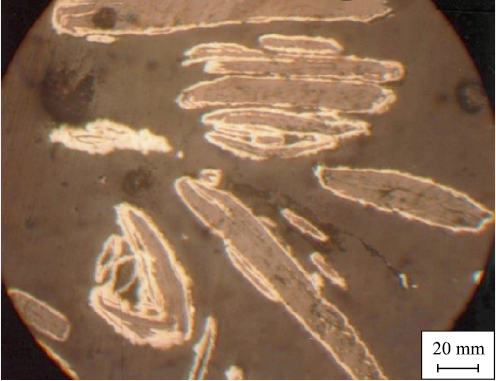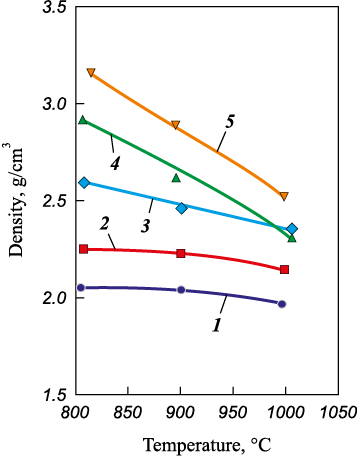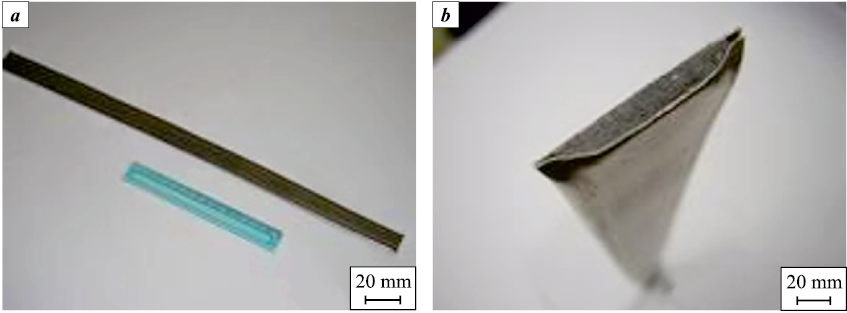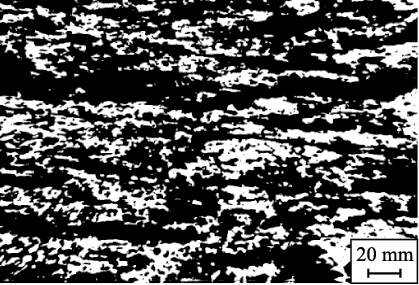Scroll to:
Obtaining and properties of rolled products from clad powders NPG-80 and Nibon-20
https://doi.org/10.17073/1997-308X-2023-1-5-11
Abstract
Antifriction tape sealing materials (TSM) are used in the manufacture of turbines. This work studied the mechanism of the increase in thickness of rolled products. The study showed that internal oxides of powder particles, which are reduced during sintering and annealing in hydrogen, cause a change in the size of tapes and compacts from NPG-80 and Nibon-20 clad powders. The distinctive feature of powders used in the work is the presence of a nickel shell around the particle of the solid lubricant (graphite or boron nitride). It was shown that an increase in sintering temperature and heating time to isothermal holding intensifies the growth of the tapes and samples The studies carried out point to a relationship between reduction processes occurring in hydrogen during heating, sintering, and annealing of NPG-80 and Nibon-20 powders with an increase in the thickness of the tape containing the solid lubricant in its composition. An increase in the duration of heating to isothermal holding at 1150 °C is accompanied by an increase in the thickness of rolled stock. Sintering of TSM Nibon-20 in the first mode (4 h to 1150 °C) gives an increase in thickness by 5-7 %, whereas sintering in the second mode (9 h to 1150 °C) gives an increase of 12-13 %. For NPG-80, the increase in thickness is 3-7 % and 8-11 %, respectively. This leads to some decrease in the physical and mechanical properties of TSM. Lower temperatures and higher heating rates are recommended for the sintering of sheet materials from NPG-80 and Nibon-20 in the hydrogen atmosphere. The increase in thickness of TSM from clad powders NPG-80 and Nibon-20 can be avoided if the sintering (heating) is carried out under pressure. By the method of electric rolling and subsequent hot rolling TSM is obtained from Nibon-20.
Keywords
For citations:
Mal'tsev I.M., Getmanovsky Yu.A. Obtaining and properties of rolled products from clad powders NPG-80 and Nibon-20. Powder Metallurgy аnd Functional Coatings (Izvestiya Vuzov. Poroshkovaya Metallurgiya i Funktsional'nye Pokrytiya). 2023;17(1):5-11. https://doi.org/10.17073/1997-308X-2023-1-5-11
Introduction
Antifriction tape sealing materials (TSM) are used in the manufacture of turbines. TSM close the gap between the turbine blades and the turbine housing. The tapes must have a specific set of properties, e.g., wear out when a turbine blade cuts into them, have a low coefficient of friction and have heat resistance and heat stability. Most commonly, for the creation of TSM, powder metallurgy methods are used. Powder materials for TSM are compositions from a matrix on a nickel or nichrome base with inclusions of solid lubricants (hexagonal boron nitride ( hBN) with a crystal lattice similar to graphite and also graphite) evenly distributed in it and are characterized by a certain level of porosity.
The main forming techniques used for the processing of such materials are extrusion and roll forming. At present, tape roll forming from composite powder materials has been successfully introduced on an industrial scale at PJSC Vyksunsky Metallurgical Plant (Vyksa, Porous Rolled Stock Production Unit) [1–8]. Industrial technology of TSM comprises charge preparation, strip rolling, sintering and hot rolling to clad the primary powder material with compact heat-resistant substrates.
TSM rolling technology features a set of technological hindrances: difficulties in forming highly fluid powder compositions, restrictions on the amount of introduced non-forming powder phase (solid lubricant), and the formation of a film from a layer of solid lubricants particles on rolling mill rolls. These factors are detrimental to the rolling forming.
This work studied the mechanism of the increase in thickness of rolled products. It was found that internal oxides of powder particles, which are reduced during sintering and annealing in hydrogen cause a change in the size of tapes and compacts from NPG-80 and Nibon-20 clad powders. The study revealed that an increase in sintering temperature and heating time to isothermal holding intensifies the growth of the tapes and samples. Particular features of sintering and annealing of the TSM were studied, and a new forming method of powder compositions by electric rolling has been developed to eliminate technological limitations that hinder the development of a new generation of TSMs containing up to 80 vol.% of solid lubricant particles. The aim of the study was to obtain materials from clad powders NPG-80 and Nibon-20 by rolling, including electric and hot rolling.
Materials and Methods
The distinctive feature of powders used in the work is the presence of a 9–12 μm thick nickel shell around the particle of the solid lubricant (graphite or boron nitride), see Fig. 1. Table 1 summarizes the technological properties and composition of powders used to obtain sheets; the sheets were rolled on 200 mm diameter rolls and sintered in two modes in hydrogen: mode 1 – heating for 4 h to t = 1150 °С, holding for 2 h at this temperature, cooling in a furnace down to 400 °C, and then in the air; mode 2 – heating for 9 h to t = 1150 °C, holding for 2 h, cooling in a furnace down to 400 °C and then in the air.
Fig. 1. The structure of the +0.100 mm size particles of the NPG-80 powder
Table 1. Technological properties and size range of powders
| |||||||||||||||||||||||||||||||||
A study of the tape properties after sintering showed that an increase in the duration of heating to isothermal holding at t = 1150 °C is accompanied by an increase in the thickness of the rolled product. Sintering of the tape from Nibon-20 powder in mode 1 leads to an increase in thickness by 5–7 %, whereas sintering in mode 2 gives a thickness increase of 12–13 %. For NPG-80, the increase in thickness is 3–7 % and 8–11 %, respectively. This, in turn, leads to worsening of physical and mechanical properties of the tape (see Table 2).
Table 2. Influence of the sintering mode on the physical
|
A change in the material properties also occurs when the samples are annealed in hydrogen for 2 h at t = 950 °C after sintering and subsequent hot rolling (Table 3). Similarly to sintering, annealing also leads to the thickening of the NPG-80 tape by 7 % and the Nibon-20 tape by 10 %. Repeated annealing of these tapes results in an increase in their thickness by 4–5 %. The observed changes in the geometry of the tapes lead to a deterioration of the properties of the antifriction sealing material due to an increase in porosity. To identify the causes associated with an increase in the thickness of powder rolled stock during sintering and annealing, the powders were reduced for 1 h at t = 300 °C in hydrogen. Table 4 shows the properties of the powders after annealing.
Table 3. Properties of the powder tapes after annealing
Table 4. Technological properties of the powders before and after the annealing
| ||||||||||||||||||||||||||||||||||||||||||||||||||||||||||||||||||||||||||||||||||
The study of powders showed that the content of fine particles mainly changes during annealing (see Table 4). Besides, there is a decrease in the mass (by 5 %) of powder samples annealed in a reducing medium (hydrogen), which indicates a considerable oxidation of the powder in the as-received state. The study of the powder particles by the breakdown voltage method demonstrated that oxides are located both inside and outside the nickel shell. See [7; 8] for the details on the technique for determining the breakdown voltage of powder filling and the device used for the implementation of this technique. Experimentally measured average thickness of the oxide layer was 1.7·10–5 mm, whereas the thickness of the shell determined microscopically had a mean value of 9·10–3 mm. Measurement of the oxide layer of the shell of the powders after reduction showed that during annealing there is a sharp decrease in its thickness down to a value of 1.06·10–6 mm.
The study of shrinkage kinetics during sintering on Nibon-20 samples of different density sintered in hydrogen at t = 800, 900, and 1000 °C revealed that an increase in the sintering temperature leads to a decrease in the samples’ density (Fig. 2).
Fig. 2. The dependence of the density of Nibon-20 pellets |
The reduction reactions occurring inside the nickel shell cause the formation of moisture, while heating creates an excess pressure of superheated vapours, leading to swelling of the powder particles and, consequently, an increase in the thickness of the TSM sample. These processes are intensified if the duration of heating to the temperature of isothermal sintering increases, when the process of thermal consolidation of particles has approximately the same rate as the reduction reaction (see Table 2). An increase in the initial density of the pellets creates the conditions for a greater decrease in density when the sintering temperature is increased (see Fig. 2). This is due to the fact that samples of clad particles have a higher gas pressure inside the shell when they first form a denser metal matrix, which prevents the gas from escaping from the clad particle during heating. The through porosity also decreases.
The X-ray phase analysis was not carried out due to technical difficulties in obtaining samples already containing 80 vol.% solid lubricant (graphite or boron nitride). The studies carried out demonstrated that sintering sheet materials from powders of solid lubricants clad with nickel in a hydrogen atmosphere to obtain the required properties is recommended in lower temperatures and at higher heating rates.
Overcoming the issue
The increase in thickness of TSM from clad powders NPG-80 and Nibon-20 can be avoided if the sintering (heating) is carried out under pressure. There are methods of rolling the powder, combined with its heating in a furnace placed above horizontally arranged rolls. In this case, difficulties arise with uniform heating of the powder bulk and its transfer into the forming zones. There are also methods of electric sintering in rolls with alternating electric current supplied to the rolls in different design options [2–4], however, there are issues associated with the stationarity of the rolling and electric sintering process.
NNSTU has developed a method for electric pulse sintering of metal powder and a device for the implementation of this method [5]. The device consists of a rolling mill and an electric pulse generator. A pulsed electric current with an adjustable duty cycle is supplied to the electrode rolls isolated from the rolling stand. Electric current runs directly between the rolls. To manufacture the TSM, high-density pulsed currents are used: 108–109 A/m2.
The rolling of various powders and compositions at the electric rolling plant revealed the features of the technology of forming and sintering by a new method. The interrelation of particle sizes, their elastic properties and the reduction factor of the powder material with the type of the electric rolling process has been established. Based on the mathematical modelling of the temperature field in the particle–contact–particle system, a method of analytical calculations was developed. This method allows for determining the mechanism (solid- or liquid-phase) of the powder electric sintering process during rolling based on its known parameters of electric rolling and the technological, electrical, and physical properties of powders [6].
Experimental tape materials based on iron powders, corrosion-resistant steels, and composite materials have been obtained by the electric rolling method [6].
The solid lubricant particles of boron nitride in the TSM act as dielectric particles located in the conductive metal matrix of the material and affect the electric rolling. The properties of electrically rolled powder materials largely depend on the Joule effect ability – with the growth of the effect, the strength of interparticle contacts and the entire electrically rolled material increases. Electrical and physical effects that strengthen the material and the interparticle contact itself arise, if during forming of a metal powder by rolling and other forming methods, an electric current and an electromagnetic field are applied to the deformation zone [7; 8]. Here, the electrical and physical properties of the conductor material itself, the electric and plastic effect, and other effects have an important role, which attracts a lot of attention of foreign and domestic researchers [9–16].
The emergence of a pulsed electromagnetic field and the flow of current through the formed powder material have expanded the possibilities of the rolling forming technique. For example, the shedding of the edges of the tape during the rolling of highly fluid powders was eliminated, having a positive effect on the macrostructure of the powder tribotechnical sealing material. This was especially noticeable on such important powders as Nibon-20 and NPG-80, compositions of nichrome and boron nitride powders. The pinch effect, which leads to compression of the conducting powder body, increased the density of the material [7], which allowed for the obtaining of powder rolled stock with a higher interparticle contact strength [12].
Under the conditions of forming at low pressure (100 MPa) and concomitant passing of a high density current through the compact from Nibon-20 powder, a sealing powder material with a porosity of only 3 % was obtained. Other tape materials can also be produced by electric rolling. The results of studies in the field of electric compacting of metal powder materials show the hardening of metal materials under the influence of an electromagnetic field [13–20]. Modern technologies of metal materials processing use high-density currents [21–23].
The use of traditional elements of technology together with the introduction of electric rolling allowed for the developing of a new version of the technology for obtaining rolled TSM from Nibon-20 powder. The powder was rolled on an electric rolling plant [5] in rolls with a 0.2 m diameter and a width of 0.02 m with an electric current applied to the forming center. The properties of the finished strips were similar to the properties to rolled stock sintered in furnaces at a temperature of 900 °C. The resulting tapes were cut and placed in packages of 0.3 mm thick NP-2 nickel foil. The resulting assembly was subjected to hot rolling on an installation designed by NNSTU at a temperature of 850 °C with a degree of deformation of 20–25 % in a hydrogen medium. Fig. 3 shows the exterior of nickel-clad sealing materials.
Fig. 3. Nickel-clad TSM element from Nibon-20 powder |
Physical and mechanical properties of the obtained material meet the requirements for sealing elements of turbines, for example, for TSM based on nichrome with solid lubricant from boron nitride. For instance, the investigated material from Nibon-20 has a tensile strength of 130–135 MPa, a hardness of 80–86 MPa, a relative density of 94–95 %, and a thickness of the sealing material layer of 2.00–2.22 mm. The advantage of this material is the high content of the non-forming phase (boron nitride), which reaches 80 vol.% in TSM – an unprecedented case.
Fig. 4 shows the structure of the TSM from NPG-80. In this case, a 5–20 µm thick metallic nickel matrix has a texture stretching along the direction of rolling.
Fig. 4. The microstructure of TSM from NPG-80 powder |
Conclusion
The study showed that internal oxides of powder particles, which are reduced during sintering and annealing in hydrogen, cause a change in the size of tapes and compacts from NPG-80 and Nibon-20 clad powders. An increase in sintering temperature and heating time to isothermal holding intensifies the growth of the tapes and samples. The properties of TSMs containing solid lubricants depend on the rolling and sintering conditions.
The use of electric rolling for clad Nibon-20 and NPG-80 powders allows for forming of compositions containing up to 80 vol.% solid lubricant, the tape of this composition is suitable for subsequent hot rolling in packs. Such a technology allows to create TSM with a high content of graphite or boron nitride.
References
1. Сорокин В.К. Производство порошкового проката. М.: Металлургиздат, 2002. 296 с.
2. Olevsky E.A., Aleksandrova E.V., Ilyina A.M., Novoselov A.N., Pelve K.Yu., Grigoriev E.G. Electroconsolidation of powder materials. I. Methods of low and high-voltage consolidation. Fizika i khimiya obrabotki mate-rialov. 2013;(2):53-64. (In Russ.).
3. Olevsky E.A., Aleksandrova E.V., Ilyina A.M., Novoselov A.N., Pelve K.Yu., Grigoriev E.G. Electroconsolidation of powder materials. II. Consolidated materials and simulation of the processes of consolidation. Fizika i khi-miya obrabotki materialov. 2013;(4):45-68. (In Russ.).
4. Olevsky E.A., Aleksandrova E.V., Ilyina A.M., Dudina D.V., Novoselov A.N., Pelve K.Y., Grigoryev E.G. Outside mainstream electronic databases: Review of studies conducted in the USSR and post-soviet countries on electric current-assisted consolidation of powder materials. Materials. 2013;6(10):4375-4440. https://doi.org/10.3390/ma6104375
5. Mal'tsev I.M., Petrikov V.G. Installation for electric pulsed sintering of conducting powders during rolling. Powder Metallurgy and Metal Ceramics. 1993;32(3):277-279. https://doi.org/10.1007/BF00559764
6. Mal'tsev I.M. Properties of powdered electric rolling. Zago tovitel'nye proizvodstva v mashinostroenii. 2011;(9): 30-38. (In Russ.).
7. Mal'tsev I.M. The effect of the electromagnetic field and skin and pinch effects on electrorolling metal powder materials under high-density pulse currents. Russian Journal of Non-Ferrous Metals. 2009;50(2):142-146. https://doi.org/10.3103/S1067821209020138
8. Mal'tsev I.M. Electrical rolling of a metal powder in roll electrodes with a high-density current. Russian Journal of Non-Ferrous Metals. 2010;51(4):342-346. https://doi.org/10.3103/S1067821210040152
9. Guan L., Tang G., Chu P.K. Recent advances and challenges in electroplastic manufacturing processing of metals. Journal of Materials Research. 2010;25(7):1215-1224. https://doi.org/10.1557/JMR.2010.0170
10. Nguyen-Tran H.D., Oh H.S., Hong S.T, Han H.N, Cao J., Ahn S.H., Chun D.M. A review of electrically-assisted manufacturing. International Journal of Precision Engineering and Manufacturing-Green Technology. 2015;2(4):365-376. https://doi.org/10.1007/s40684-015-0045-4
11. Xiang S., Xinfang Z. Dislocation structure evolution under electroplastic effect. Materials Science and Engineering: A. 2019;761:138026. https://doi.org/10.1016/j.msea.2019.138026
12. Mal'tsev I.M. Research of electrorolled materials. Zavodskaya laboratoriya. Diagnostika materialov. 2018; 84(11):36-41. (In Russ.). https://doi.org/10.26896/1028-6861-2018-84-11-36-41
13. Pan L, He W., Gu B. Effects of electric current pulses on mechanical properties and microstructures of as-quenched medium carbon steel. Materials Science and Engineering: A. 2016;662:404-411. https://doi.org/10.1016/j.msea.2016.03.031
14. Tyler J., Grimm, Laine Mears. Electrically assisted pulse forming using closed-loop force control. Journal of Manufacturing Processes. 2021;71:528-540. https://doi.org/10.1016/j.jmapro.2021.09.029
15. Morsi K., El-Desouky A., Johnson B., Mar A., Lanka S. Spark plasma extrusion (SPE): Prospects and potential. Scripta Materialia. 2009;61(4):395-398. https://doi.org/10.1016/j.scriptamat.2009.04.026
16. Desouky A.El., Moon K.S., Kassegne S.K., Morsi K. Green Compact temperature evolution during current-activated tip-based sintering (CATS) of nickel. Me tals. 2013;3(2):178-187. https://doi.org/10.3390/met3020178
17. Zhyltsov A., Kondratenko I., Vasyuk V. Linear electromechanical transducer in the systems of welded joints of electrodynamic processing. In: Handbook of research on energy-saving technologies for environmentally-friendly agricultural development. IGI Global, 2020. P. 32. https://doi.org/10.4018/978-1-5225-9420-8.ch016
18. Fais A., Actis Grande M., Forno I. Influence of processing parameters on the mechanical properties of ElectroSinter-Forged iron based powders. Materials & Design. 2016;93:458-466. https://doi.org/10.1016/j.matdes.2015.12.142
19. Deng H., Dong J., Boi F., Saunders T., Hu C., Grasso S. Magnetic field generated during electric current-assisted sintering: from health and safety issues to Lorentz force effects. Metals. 2020;10(12):1653. https://doi.org/10.3390/met10121653
20. Wang Q., Ma Z., Wang X., Zhai Z. Study on the electromagnetic stress of the crack tip on a current-carrying metal plate. Shenyang Jianzhu Gongcheng Xueyuan Xuebao (Zi-ran Kexue Ban). 2010;26(3):571-574.
21. Stolyarov V., Rubanik V. Cold rolling electrostimulation of hard-deform alloys. Key Engineering Materials. 2022;910:308-313. https://doi.org/10.4028/p-fcq55e
22. Pan L., He W., Gu B. Non-uniform carbon segregation induced by electric current pulse under residual stresses. Journal of Materials Processing Technology. 2015;226: 247254. https://doi.org/10.1016/j.jmatprotec.2015.07.017
23. Sorokova S.N., Knyazeva A.G., Pobol A.I., Goranskyi G.G. Mathematical modeling of pulsed electro contact sintering of carbide powder composition. Advanced Materials Research. 2014;1040:495-499. https://doi.org/10.4028/www.scientific.net/AMR.1040.495
About the Authors
I. M. Mal'tsevRussian Federation
Il'ya M. Mal'tsev - Cand. Sci. (Eng.), Associate Prof. of the Department “Materials science, technologies of materials and heat treatment of metals”.
24 Minina Str., Nuzhny Novgorod 603950
Yu. A. Getmanovsky
Russian Federation
Yurii A. Getmanovsky - Assistant of the Department “Materials science, technologies of materials and heat treatment of metals”.
24 Minina Str., Nuzhny Novgorod 603950
Review
For citations:
Mal'tsev I.M., Getmanovsky Yu.A. Obtaining and properties of rolled products from clad powders NPG-80 and Nibon-20. Powder Metallurgy аnd Functional Coatings (Izvestiya Vuzov. Poroshkovaya Metallurgiya i Funktsional'nye Pokrytiya). 2023;17(1):5-11. https://doi.org/10.17073/1997-308X-2023-1-5-11





































